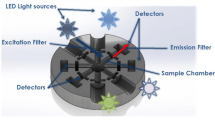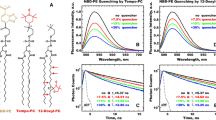Abstract
The interactions of horse heart apocytochromec with membrane interfaces were studied on membrane models including micelles of the anionic surfactant sodium dodecyl sulfate (SDS), the micelle forming lipid analogs dodecylphosphoglycol (Cl2PG), tetradecylphosphoglycol (Cl4PG), and dodecylphosphocholine (Cl2PN), and the negatively charged phospholipid 1-palmitoyl-2-oleoylsn-glycero phosphocholine (POPS) forming small unilamellar vesicles (SUV). The time-resolved fluorescence of the single tryptophan residue (Trp-59) emission was monitored to characterize the modifications of the conformational equilibrium and of the internal dynamics of the protein, which can be brought about by its binding to these model membranes. In most of the cases, as for the protein in solution, the excited state lifetime distribution of the Trp emission was described by four discrete classes, whose relative proportions and barycenters vary significantly in the different complexes formed. In the complex with POPS, however, the decay analysis showed only 3 lifetime classes: the long lifetime class displayed a bary-center value smaller than that observed for the protein in aqueous solution but with a much higher proportion, indicating a stabilization of this conformer in the membrane-bound form of the protein. A similar sensitivity of theTrp-59 excited state to deactivation by thermal collisions in water and in the protein/POPS complex was observed, indicating a probable location ofTrp-59 at the membrane/water interface. The effects of protein binding to C12PN, C12PG and C14PG micelles on the long life-time class proportion were similar to that of POPS but, in addition, there was a large contribution of a short lifetime component which was absent in POPS vesicles. The bary-center values of the excited state lifetime classes were comparable in these membrane systems, suggesting thatTrp-59 is not transferred to a non-polar environment. Binding of apocytochrome c to SDS micelles strongly reduced the lifetime class barycenters and, in contrast to the other membrane systems, strongly favored the contribution of the shortest lifetime class at the expense of the c3 class. This suggests an interaction of theTrp-59 with the sulfur containing head-group of this surfactant. The indole ring mobility is reduced at the interface contacts. A fastTrp-59 mobility with a large amplitude is suggested in the complex with POPS by an initial anisotropy value lower than the expected one of 0.295 measured in vitrified medium. These observations can be correlated with the induction of α-helical structure after interactions of apocytochromec with membrane model systems (de Jongh and de Kruijff 1990).
Similar content being viewed by others
Abbreviations
- AOT:
-
sodium bis-(2-ethylhexyl)sulfosuccinate
- C12PG:
-
dodecylphosphoglycol
- C14PG:
-
tetradecylphosphoglycol
- C12PN:
-
dodecylphosphocholine
- MEM:
-
Maximum Entropy Method
- NMR:
-
nuclear magnetic resonance
- POPS:
-
1-palmitoyl, 2-oleoyl-sn-glycerophosphoserine
- SUV:
-
small unilamellar vesicles
- Trp:
-
tryptophan
References
Berkhout TA, Rietveld A, De Kruijff B (1987) Preferential lipid association and mode of penetration of apocytochromec in mixed model membranes as monitored by tryptophanyl quenching using brominated phospholipids. Biochim Biophys Acta 897:1–4
Brochon JC, Livesey AK (1991) (in preparation)
Brochon JC, Livesey AK (1987) Time-resolved fluorimetry using synchrotron radiation and Maximum Entropy Method of analysis. In: Douglas RH, Moan J, Dall'Acqua F (eds): Proceedings of the 2nd Congress of the European Society for Photobiology. Plenum Press, New York, pp 21–29
Chang MC, Petrich JW, McDonald, DB, Fleming GR (1983) Non-exponential fluorescence decay of tryptophan, tryptophylglycine and glycyltryptophan. J Am Chem Soc 105:3819–3824
Cowgill RW (1967) Fluorescence and protein structure. XI-Fluorescence quenching by disulfide and sulhydryl groups. Biochim Biophys Acta 140:37–44
Creed D (1984) The photophysics and photochemistry of the near-absorbing amino acids-I. Tryptophan and its simple derivatives. Photochem Photobiol 39:537–562
Datema KP, Visser AJWG, van Hoek A, Wolfs CJAM, Spruijt RB, Hemminga MA (1987) Time-resolved tryptophan fluorescence anisotropy investigation of bacteriophage M13 coat protein in micelles and in mixed bilayers. Biochemistry 26:6145–6152
De Jongh HHJ, de Kruijff B (1990) The conformational changes of apocytochromec upon binding to phospholipid vesicles and micelles of phospholipid based detergents: a circular dichroism study. Biochim Biophys Acta 1029:105–112
Gallay J, Vincent M, Nicot C, Waks M (1987) Conformational aspects and rotational dynamics of synthetic adrenocorticotropin-(1–24) and glucagon in reverse micelles. Biochemistry 26:5738–5747
Hennig B, Koehler H, Neupert W (1983) inMitochondria. In: Schweyen RJ, Wolff K, Kaudewitz F (eds) de Gruyter, Berlin, pp 551–561
Ichiye T, Karplus M (1983) Fluorescence depolarization of tryptophan residues in proteins: a molecular dynamics study. Biochemistry 22:2884–2893
John E, Jähnig F (1988) Dynamics of melittin in water and membranes as determined by fluorescence anisotropy decay. Biophys J 54:817–827
Johnson ID, Hudson B (1989) Environmental modulation of M13 coat protein tryptophan fluorescence dynamics. Biochemistry 28:6392–6400
Jordi W, de Kroon AIPM, Killian JA, de Kruijff B (1990) The mitochondrial precursor protein apocytochromec influences the order of the headgroup and acyl chain of phosphatidylserine dispersions. A2H and31P NMR study. Biochemistry 29:2312–2321
Kinosita K, Kawato S, Ikegami A (1977) A theory of fluorescence polarization decay in membranes. Biophys J 20:289–305
Kuipers OP, Vincent M, Brochon JC, Verheij HM, de Haas GH, Gallay J (1990) Effects of ligand binding on the conformation and internal dynamics in specific regions of porcine pancreatic phospholipase A2 with tryptophan as probe: a study combining time-resolved fluorescence spectroscopy and site-directed mutagenesis. Proc Soc Opt Eng 1204:100–111
Levy RM, Szabo A (1982) Initial fluorescence depolarization in tyrosines in proteins. J Am Chem Soc 104:2073–2075
Lipari G, Szabo A (1980) Effect of librational motion on fluorescence depolarization and nuclear magnetic relaxation in macromolecules and membranes. Biophys J 30:489–506
Livesey AK, Brochon JC (1987) Analyzing the distribution of decay constants in pulse-fluorimetry using the Maximum Entropy Method. Biophys J 52:693–706
Nicot N, Vacher M, Vincent M, Gallay J, Waks M (1985) Membrane protein in reverse micelles: Myelin basic protein in a membrane-mimetic environment. Biochemistry 26:5739–5747
Peng K, Visser AJWG, van Hock A, Wolfs CJAM, Hemminga MA (1990) Analysis of time-resolved fluorescence anisotropy in lipid-protein systems. II Application to tryptophan fluorescence of bacteriophage M13 coat protein incorporated in phospholipid bilayers. Eur Biophys J 18:285–293
Petrich JW, Chang MC, McDonald DB, Fleming GR (1983) On the origin of nonexponential fluorescence decay in tryptophan and its derivatives. J Am Chem Soc 105:3824–3832
Rietveld A, Ponjee GAE, Schiffers P, Jordi W, Van de Coolwick PJFM, Demel RA, Marsh D, De Kruijff B (1985) Investigations on the insertion of the mitochondrial precursor protein apocytochromec into model membranes. Biochim Biophys Acta 818:398–409
Snel MME, Kaptein R, de Kruijff B (1991) Interaction of apocytochromec and derived polypeptide fragments with sodium dodecyl sulfate micelles monitored by photochemically induced dynamic nuclear polarization H1 NMR and fluorescence spectroscopy. Biochemistry 30:3387–3395
Steiner RF, Kirby EP (1969) The interaction of the ground and excited states of indole derivatives with electron scavengers. J Phys Chem 73:4130–4135
Szabo AG, Rayner DM (1980) Fluorescence decay of tryptophan conformers in aqueous solution. J Am Chem Soc 102:554–563
Vincent M, Brochon JC, Merola F, Jordi W, Gallay J (1988) Nanosecond dynamics of horse heart apocytochromec in aqueous solution as studied by time-resolved fluorescence of the single tryptophan residue (Trp-59). Biochemistry 27:8752–8761
Vogel H, Nilsson L, Rigler R, Voges KP, Jung G (1988) Structural fluctuations of a helical polypeptide traversing a lipid bilayer. Proc Natl Acad Sci USA 85:5067–5071
Wahl Ph (1979) Analysis of fluorescence anisotropy decay by least square method. Biophys Chem 10:91–104
Author information
Authors and Affiliations
Rights and permissions
About this article
Cite this article
Vincent, M., Gallay, J. The interactions of horse heart apocytochromec with phospholipid vesicles and surfactant micelles: time-resolved fluorescence study of the single tryptophan residue (Trp-59). Eur Biophys J 20, 183–191 (1991). https://doi.org/10.1007/BF01561141
Received:
Accepted:
Issue Date:
DOI: https://doi.org/10.1007/BF01561141




